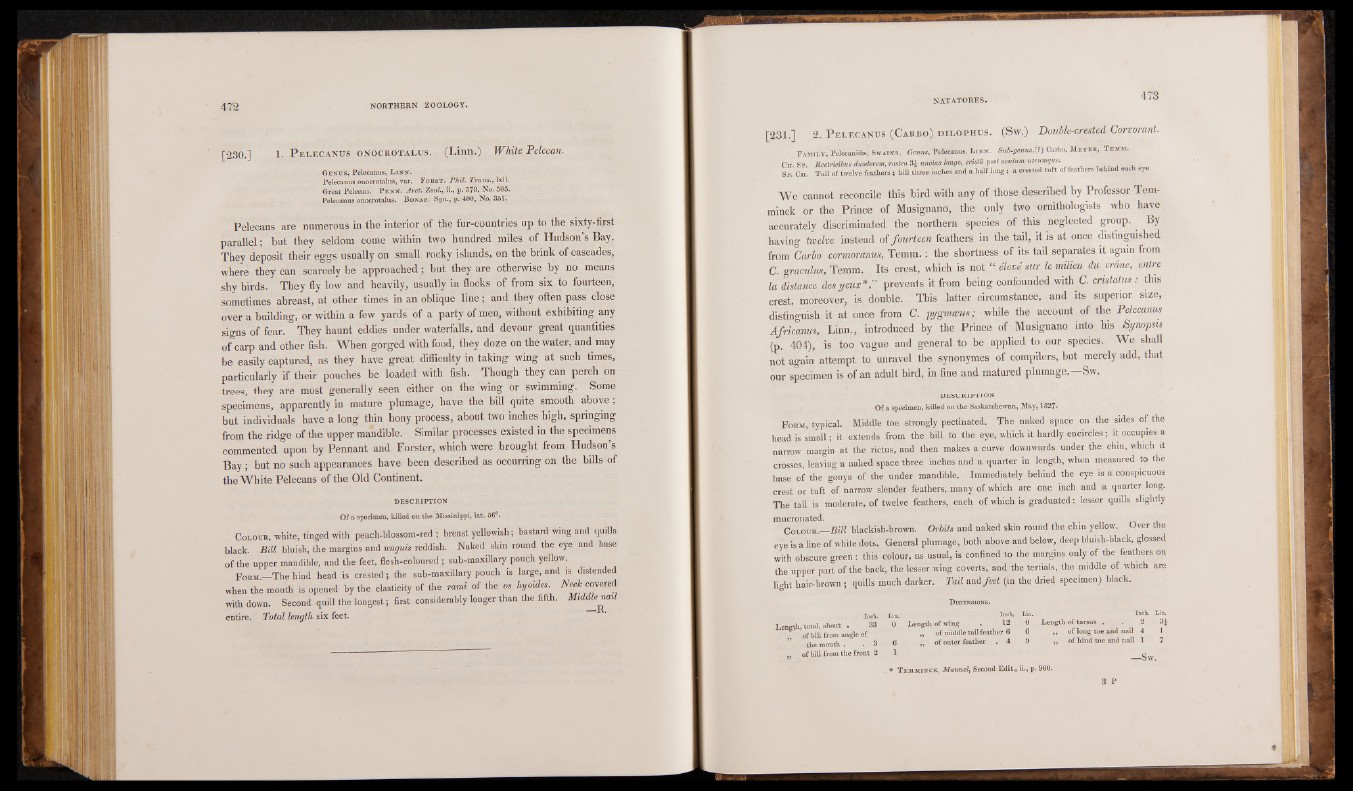
[230.] 1. P elecanus onocrotalus. (Linn.) White Pelecan.
Genus, Pelecanus, Lin n .
Pelecanus onocrotalus, var. Forst . Phil. Trans., lxii.
Great Pelecan. P enn. Arct.Zool., ii., p. 578, No. 505.
Pelecanus onocrotalus. Bonap. Syn., p. 400, No. 351.
Peleoans are numerous in the interior of the fur-countries up to the sixty-first
parallel; but they seldom come within two hundred miles of Hudson’s Bay.
They deposit their eggs usually on small rocky islands, on the brink of cascades,
where they can scarcely be approached; but they are otherwise by no means
shy birds. They fly low and heavily, usually in flocks of from six to fourteen,
sometimes abreast, at other times in an oblique line; and they often pass close
over a buildingTor within a few yards of a party of men, without exhibiting any
signs of fear. They haunt eddies under waterfalls, and devour great quantities
of carp and other fish. When gorged with food, they doze on the water, and may
be easily captured, as they have great difficulty in taking wing at such times,
particularly if their pouches be loaded with fish. Though they can perch on
trees, they are most generally seen either on the wing or swimming. Some
specimens, apparently in mature plumage, have the bill quite smooth above ;
but individuals have a long thin bony process, about two inches high, springing
from the ridge of the upper mandible. Similar processes existed in the specimens
commented upon by Pennant and Forster, which were brought from Hudson’s
Bay; but no such appearances have been described as occurring on the bills of
the White Pelecans of the Old Continent.
DESCRIPTION .
Of a specimen, killed on the Missinippi, lat. 56°.
Colour, white, tinged with peach-blossom-red ; breast yellowish; bastard wing and quills
black. BUI bluish, the margins and unguis reddish. Naked skin round the eye and base
of the upper mandible, and the feet, flesh-coloured ; sub-maxillary poach yellpw.
F orm.— Thp hind head is crested; the sub-maxillary pouch is large, and is distended
when the mouth is opened by the elasticity of the rami of the os hyoides. Neck^covered
with down. Second quill the longest; first considerably longer than the fifth. Middknail
entire. Total length six feet.
[231.] 2. P elecanus (C arbo) d il o ph u s . (Sw.) Double-crested Corvorant.
Family, Pelecanidæ, Swains. Genus, Pelecanus, Linn. Sub-genus,(?) Carbo, Meyer, Temm.
Ch . Sp. Rectricibus duodecem, rostro 3£ unoias longo, crista post oculum utrvmque. .....
Sp. Ch. Tail of twelve feathers ; bill three inches and a half long ; a crested tuft of feathers behind each eye.
We cannot reconcile this bird with any of those described by Professor Tem-
minck or the Prince of Musignano, the only two ornithologists who have
accurately discriminated the northern species of this neglected group. By
having twelve instead of fourteen feathers in the tail, it is at once distinguished
from Carbo cormorams, Temm. : the shortness of its tail separates it again from
C. graculus, Temm. Its crest, which is not “ élevé sur le milieu du crâne, entre
la distance des yeux*,” prevents it from being confounded with C. cristatus : this
crest, moreover, is double. This latter circumstance, and its superior size,
distinguish it at once from C. pygmasus; while the account of the Pelecanus
Africanus, Linn., introduced by the Prince of Musignano into his Synopsis
(p. 404), is too vague and general to be applied to our species. We shall
not again attempt to unravel the synonymes of compilers, but merely add, that
our specimen is of an adult bird, in fine and matured plumage.—Sw.
DESCRIPTION
Of a specimen, killed on the Saskatchewan, May, 1827.
F orm, typical. Middle toe strongly pectinated. The naked space on the sides of the
head is small; it extends from the bill to the eye, which it hardly encircles; it occupies a
narrow margin at the rictus, and then makes a curve downwards under the chin, which it
crosses, leaving a naked space three inches and a quarter in length, when measured to the
base of the gonys of the under mandible. Immediately behind the eye is a conspicuous
crest or tuft of narrow slender feathers, many of which are one inch and a quarter long.
The tail is moderate, of twelve feathers, each of which is graduated: lesser quills slightly
mucronated. ,
C olour.__Bill blackish-brown. Orbits and naked skin round the chin yellow. Over the
eye is a line of white dots. General plumage, both above and below, deep bluish-black, glossed
with obscure greeti: this colour, as usual, is confined to the margins only of the feathers on
the upper part of the back, the lesser wing coverts, and the tertials, the middle of which are
light hair-brown ; quills much darker. Tail and feet (in the dried specimen) black.
Dimensions.
■ Inch.
Length, total, about . 33
• „ of bill from angle of
the mouth . . 3
„ of bill from the front 2
kin. Inch. Lin. Inch. Lin.
0* Length of wing . 12 0 Length of tarsus - • 2 3*
„ of middle tail feather 6 6 „ of long toe and nail 4 1
6 „ of outer feather . 4 9 „ of hind toe and nail 1 7
1 — Sw.
* TemmincKj Manuel, Second Edit., ii., p. 900.